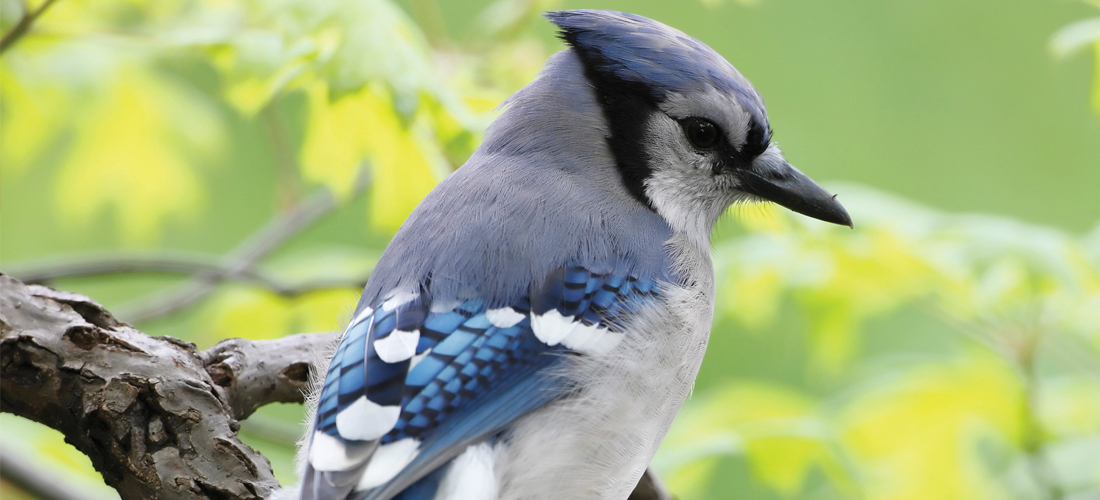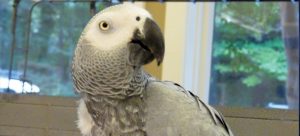
Jay Day
There’s more to the ubiquitous blue jay than meets the eye
By Susan Campbell
The blue jay is one of those species most of us can instantly recognize. But how well do we really know this medium-sized raucous bird found at feeders or flying around in the treetops at any time of the year? Though their behavior may not seem particularly remarkable at first glance, they are complex and unique creatures.
Jays are closely related to crows, a highly evolved species. So it shouldn’t come as a surprise that they exhibit an advanced degree of intelligence and have complex social systems. Blue jays remain together as a family for a relatively long period and also mate for life. And here’s a species that communicates not only with their voices but also with body language. The telltale bristling of a jay’s crest is one of the most obvious ways they express themselves. Look for a raised crest whenever an individual is alarmed or intimidated.
Although the bird’s underparts are a dingy gray, the jay’s bright blue coloration and its distinctive blue crest give the bird a cocky, imperious air. A unique brindling pattern specific to individuals also makes each bird distinctive. (Interestingly the pigment found in jay feathers is produced by melanin, which is actually brown. It is the structures on the barbs of the bird’s feathers that cause light to reflect in the blue wavelength.)
In addition to their bright coloration, jays attract attention with their loud and piercing calls. They make a variety of unusual squawks and screams, often from a perch high in the canopy. Jays are well known for mimicking other birds’ calls: especially hawks. Whether this is an alarm tactic or whether they are trying to fool other species is not clear. The great early ornithologist John Audubon interpreted this behavior as a ploy that allowed blue jays to rob nests of smaller birds, such as warblers and vireos that instinctively scatter whenever they hear the terrifying sound of a hawk hunting for prey. But modern studies of blue jay diets have not found that eggs or nestlings are particularly common foods.
Another mystery is why, in some years, these birds migrate. Blue jays are particularly fond of acorns. It may be that in years when oaks here are not very productive, jays move southward in search of their favorite food. So the number of blue jays that remain in the Piedmont and Sandhills this winter will likely depend on the mast crop — especially the abundance of white oak acorns. These acorn-lovers have a specialized pouch in their throats for carrying acorns and other large edibles, which they stash in holes and crevices for later delectation.
Blue jays also have interesting nesting habits. While males collect most of the materials — live twigs, grasses and rootlets — females create a large cup, where they incubate and brood the young birds. All the while the male feeds the broodking female — and then forages for the tiny hatchlings. Once the young have developed a good layer of down, the female will join the search for food for the family. It is not unusual for young jays to wander away from the nest before actual fledging occurs. But the wise parents are not likely to feed the begging youngsters unless they return to the nest. It is during this period that some people are convinced they need to “rescue” the wayward youngsters.
Finally, reports of “bald” blue jays are not uncommon. Do not be surprised if you see an odd-looking individual at a feeder or bird bath with virtually no feathers on its head: just dark skin. At first this was thought to be caused by feather mites that can be found on all birds to varying degrees. But now it seems there are simply individuals that lose all of their head feathers at once instead of in the normal, staggered fashion. It appears this is more likely in adolescents who are undergoing their very first molt
The next time you notice one of these noisy, crested birds take a closer look. Blue jays are fascinating — and full of surprises! OH
Susan would love to receive your wildlife sightings and photos. She can be contacted by email at susan@ncaves.com.





